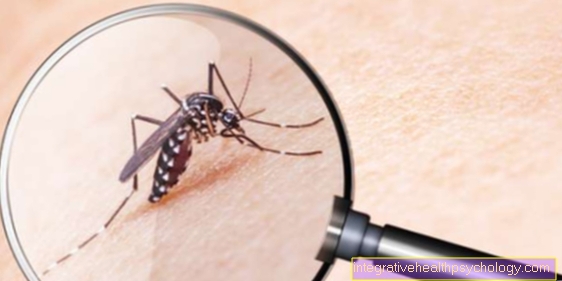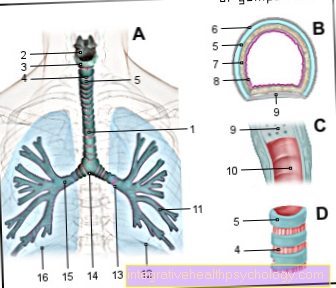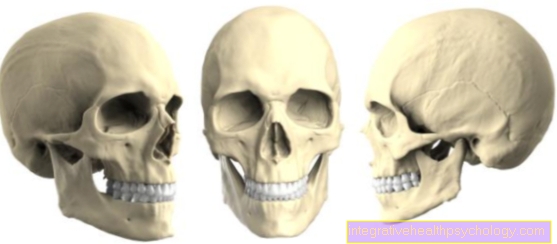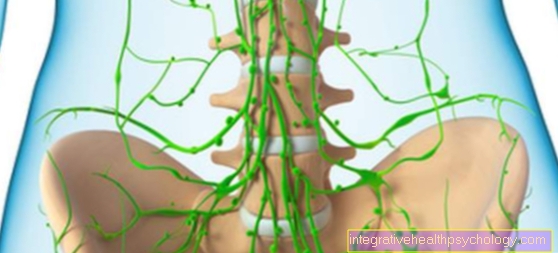The auricle
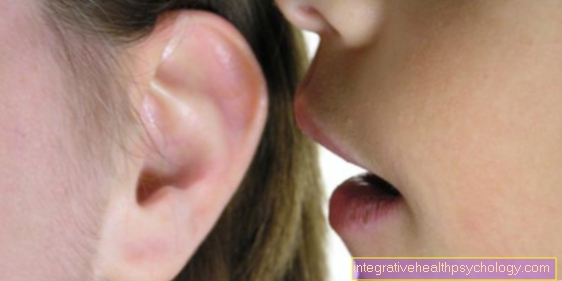
definition
The auricle, also called auricula (Latin auris - ear), is the visible, shell-shaped and cartilaginous outer part of the outer ear and, together with the outer auditory canal, forms the outer ear. Together with the middle ear, this forms the sound conduction apparatus of the human hearing organ. With the shell-like funnel shape and the cartilaginous indentations, the auricle not only serves to capture the sound waves, but also to improve directional hearing.
You might also be interested in: The human ear
anatomy
The auricle gets its shape from a cartilaginous substructure, which defines the externally visible indentations and protuberances. At the same time, the cartilage provides attachment points for the muscles on the ear, which in humans have largely become stunted and functionless, as humans no longer depend on being able to move their ears in certain directions.
The cartilage of the ear gives the ear its typical shape and is always malleable and flexible because it consists of elastic cartilage. Ears can be of different sizes, but they always have certain structures that every normal-shaped ear presents. These structures were named by anatomists so that an accurate description of the ear is possible. These include, for example, the earlobe (lobus auricularis), the wide arch of the ear (helix) or the inner arch (anthelix).
The ear is primarily supplied with blood through the external carotid artery, which supplies the ear from the front via the anterior auricular arteries and from the rear via the posterior auricular artery. There are connections between these branches via the perforating rami, which run in the skin and subcutaneous tissue of the auricle.
The lymph of the outer ear, which consists of tissue fluid and immune cells, is drained via the lymph nodes and pathways that run along the internal jugular vein (internal jugular vein). The ear is divided into three territories. The lower drains directly into the lymph nodes, which run along the internal jugular vein. The lymph of the anterior territory first flows through the lymph nodes of the parotid gland, while the posterior territory first conducts the lymph through the mastoidal lymph node stations (lymph nodes near the mastoid process).
The sensitive innervation of the auricle is complex because the ear region is the transition zone between the cranial nerves and the cervical plexus in terms of innervation. Of the cranial nerves, the facial, trigeminal, vagus, and glossopharyngeal nerves are involved. Of the nerves of the cervical plexus (plexus cervicalis), the nervus occipitalis minor and nervus auricularis magnus are involved. It should be noted that the anterior half of the ear is primarily innervated by the trigeminal nerve and the posterior half by the nerves of the cervical plexus. The entrance to the ear canal, on the other hand, is primarily innervated by the cranial nerves vagus and glossopharyngeal nerves.
The cartilage
The cartilaginous structure of the auricle gives it its typical shape and gives it the necessary stability, while it also remains elastic and soft. These properties are due to the fact that the cartilage consists of so-called elastic cartilage. This contains a particularly large number of elastic fibers made of elastin and fibrillin. Around the cartilage there is a so-called cartilage skin, also called perichondrium, which on the one hand contains tight connective tissue and on the other hand also contains cells for the regeneration of the cartilage. In addition, blood vessels run in the cartilage membrane, but they do not run through the cartilage itself. Therefore, the cartilage membrane also serves to nourish the cartilage via diffusion.
Further information on this topic can be found at: The ear cartilage - the function and piercing
The function
Due to the lack of fat, it is possible that heat can be given off through the ears. However, this thermoregulatory effect plays a minor role in humans.
Much more crucial is the function of the auricle, to capture the sound like a funnel and then to pass it on to the inner ear via the outer and middle ear. The auricle therefore belongs to the sound conduction apparatus.
The auricle not only serves to capture and transmit sound, it also plays a special role in directional hearing. The special shape of the auricle with its folds, indentations and bulges, incident sound frequencies are reflected to different degrees or amplified by resonance. These subtle differences are then processed by the nerve cells of the central nervous system. This enables spatial hearing, with the differentiation whether the sound source is in front, behind, above or below with regard to the listener.
Learn more about: Listen
Pains in the auricle
Various causes can lead to pain in the auricle. On the one hand, it can be harmless causes such as cold. The skin on the cartilage and also in the ear canal is very sensitive to cold.
If, for example, only the skin hurts, it is possible that a rash, also called eczema, has formed on the ear, which can itch and also be painful.
On the other hand, it can also be a so-called herpes zoster. This is a reactivation of the chickenpox virus that can affect anyone who has ever had chickenpox. The extremely painful herpes forms small blisters and crusts and a reddening. This clinical picture can lead to hearing loss and facial paralysis on the affected side.
Another possible cause is otitis externa, the inflammation of the outer ear. Here it can be due to an infection with viruses, fungi or bacteria, or a chronic irritation, e.g. B. in the form of moisture or mechanical stress, inflammation of the outer ear can occur, which can be dry and crusty, but also oozing.
You might also be interested in: Pain at the entrance of the ear
An otitis media, which typically causes pain in the inner part of the ear, can also radiate outwards. It is particularly important to note that small children are often unable to express themselves and only touch the auricle when they have internal ear pain, as their ear hurts.
If the aching ear is characterized by fever, exhaustion and marked overheating and reddening of the ear, it can also be a sore rose, so-called erysipelas. This is a bacterial inflammation of the skin that can be dangerous and therefore requires a visit to a doctor or clinic.
Read more on the topic: Pains in the auricle
Itching of the auricle
An itchy ear can also have a number of reasons. One of the harmless reasons is dry and irritated skin.
In addition, skin conditions that cause a rash can often lead to itching. An example of this would be neurodermatitis, in which the skin barrier function is disturbed and chronic inflammation is present.
Allergic reactions are often associated with itching. Sometimes people develop an allergy to metal components, such as: B. Nickel, from jewelry. This can result in allergic and itchy skin reactions on the ear.
The already mentioned inflammation of the outer ear can present itself as itchy. Viral, bacterial, or fungal infections can cause these. Chronic inflammation caused by oozing or mechanical irritation in particular also shows itching.
If the itching is not limited to the ear but affects the whole body, other systemic diseases can also be considered, which also range from allergic reactions to organ failure of the liver or kidneys.
The auricle inflammation
The auricle inflammation is actually an inflammation of the cartilage skin (perichondrium), which is around the elastic cartilage of the auricle. Hence it is also called perichondritis. After an injury and germ invasion, the germs can spread along the perichondrium and cause inflammation. It is important to note here that the earlobe is not affected as it contains neither cartilage nor cartilage membrane.
Treatment is via antibiotics and symptom-relieving compresses and ointments. Early therapy is important to prevent inflammation-related destruction of the cartilage tissue, as permanent deformations can occur.
For more information, see: Inflammation of the auricle
Further information on the subject of the ear can be found at:
- Outer ear
- Inner ear
- Middle ear
- Listen
- eardrum
- Earlobe
- The ear cartilage - the function and piercing
- Ear canal
Other topics that might interest you:
- Otitis media
- Herpes zoster oticus
- Big ears
- Hearing loss
- Meniere's disease
- Loosen earwax
- Remove ear wax
- Eczema in the ear






